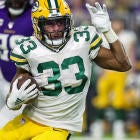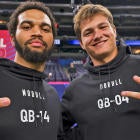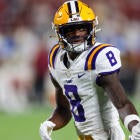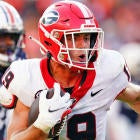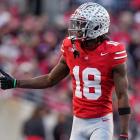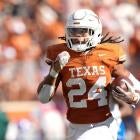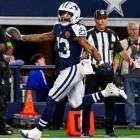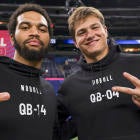With the 2019 regular season in the books, I'll be going division by division to share my initial offseason takeaways from each team.
This is mostly postseason note-taking as I emphasize what stands out most from the Stealing Signals column in 2019. We have an entire offseason of coaching and personnel changes plus additional research to break down what our 2020 Fantasy expectations will be, but I intend to refer back to these pieces as a barometer of sorts.
Chicago Bears
Snap Notes: Anthony Miller — under 60% snaps in six of first nine games, over 80% in five of final seven
Key Stat: Green zone rushes — 33 attempts, six rush touchdowns (tied second worst conversion rate in NFL)
After an exciting 2018, the Bears crashed back to Earth in 2019, and the question heading into 2020 will be where their true talent level lies. They fell from 44 offensive touchdowns in 2018 to 28 in 2019, scoring 141 fewer points as a team.
David Montgomery had an uneventful rookie season, marred by inefficiency near the goal line and Tarik Cohen's presence limiting his receiving role. Cohen finished fourth among the league's running backs with 79 catches, though his efficiency plummeted, and he finished with exactly 500 fewer yards from scrimmage than his hyper-efficient 2018.
Allen Robinson took a step forward in his second season with the Bears, and clearly put to rest the somewhat prevalent offseason narrative this team didn't have a true No. 1 receiver. Robinson entered the league at 21 years of age, so he'll turn just 27 next August, still very much in his prime and coming off the second-best season of his career despite inconsistent quarterback play. He finished fourth in the NFL in targets and was WR7 in PPR leagues and WR12 in non-PPR; he should pretty comfortably be in the top 10-15 Fantasy wide receivers for 2020.
Despite being used sparingly in the first half of the year, Anthony Miller came on strong late in his second season, and improved his receiving numbers across the board from 2018, with the glaring exception being touchdowns. He'll be a polarizing figure for 2020.
Mitchell Trubisky took a step back as a passer in Year 3, finishing with a career-low YPA and seeing his impressive touchdown rate from 2018 crumble in 2019. He also finished with a career low in rushing yardage despite starting more games than he had in either prior season, and that combination makes him a risky Fantasy bet for 2020.
Signal: Allen Robinson — elite talent; Tarik Cohen — dominated RB receptions
Noise: Team — terrible green zone rush attempt conversion rate
Detroit Lions
Snap Notes: Kerryon Johnson — over 70% for three straight games before injury
Key Stat: Matthew Stafford — 10.6 average throw depth (7.1 in 2018, 8.0 or lower in every season since 2013)
The Lions came out in 2019 with a more vertical passing attack under Darrell Bevell, utilizing the skill sets of Kenny Golladay and Marvin Jones as the top two passing options after the departures of longtime underneath targets Golden Tate and Theo Riddick in the year prior. That gave Matthew Stafford more passing yardage upside than he's had since the days of Calvin Johnson, and Stafford's 312.4 passing yards per game represented the second-highest figure of his career, and the first time he finished above 280 since 2013.
Of course, Stafford only played eight games, and the Lions' season was marred by injury. David Blough's 8.8-yard average throw depth and Jeff Driskel's 8.4 mostly confirmed the change in offensive philosophy after Stafford's injury, and the passing game will have reasonable upside going into 2020.
A big reason for that is Kenny Golladay, who finished as the WR9 in PPR and WR3 in non-PPR formats. Golladay saw just 116 targets but finished fourth in the NFL in air yards with 1,756, something that should help him maintain his high yards per target (10.3). It should also help with his touchdown rate, although touchdowns on 9.5% of targets is difficult for anyone to sustain, and we'll likely expect some regression there.
Marvin Jones also had a very high touchdown rate, punctuated by the four-score game against Minnesota in Week 7. He remains a talented deep threat but has never been one to hog targets.
Rookie tight ends don't typically take the league by storm, and any disappointment surrounding T.J. Hockenson's season is likely due to expectations peaking after he torched Arizona in Week 1. Overall, his rookie season was fine.
Danny Amendola's production closely tied to when his snap shares were highest, which happened most consistently after Hockenson and Jones went to IR.
It was a lost season for Kerryon Johnson, and the only real notable part of it was that after two weeks of playing 57% and 55% of the snaps, the Lions jettisoned C.J. Anderson and turned over at least 70% of the snaps to Johnson for the next three weeks, before Johnson's injury in Week 7. Unfortunately, I'm not sure that alone indicates he'll be workhorse going forward because: 1) He still gave up work on passing downs, never running routes on more than 52% of dropbacks; 2) Matt Patricia comes from the Bill Belichick coaching tree; 3) Johnson got hurt. When he returned, he was back to a part-time role, but I'm not sure we should have expected much different there, either.
Signal: Lions — more vertical passing attack in 2019; Kenny Golladay — room to add targets, probably due for some touchdown regression
Noise: Kerryon Johnson — could make both optimistic and pessimistic cases about what his usage might be in 2020
Green Bay Packers
Snap Notes: Aaron Jones — played more than 65% of the snaps just four times, all games where Jamaal Williams was either out or injured mid-game
Key Stat: Davante Adams — 10.6 targets per game (second most in NFL)
Aaron Jones was a star in 2019, but nearly everything about his season will be hard to trust in 2020. He only played over 65% of the snaps four times, all of which were games Jamaal Williams left early or was inactive for. In those four games, he averaged 136 yards from scrimmage, while he averaged 85 in his other 12 outings. Three of his five 100-yard rushing games came in those four games, and he scored seven of his 19 touchdowns in that sample.
Then there's how Davante Adams' absence impacted Jones' receiving role. Jones averaged 5.5 receptions in the four games Adams missed, but just 2.25 on 3.5 targets per game in the 12 Adams played.
Still, from a broader standpoint, what Jones did in 2019 was establish himself as a huge piece of the Packers' offensive puzzle, and one has to expect they'll work to keep him heavily involved even if they stay healthier in 2020. But Williams also obviously brings something they like, as evidenced by no other No. 2 taking snaps from Jones when Williams was out. It might be tough for Jones to match all of the 49 receptions, 1,558 yards from scrimmage and 19 touchdowns he posted in 2019, while Williams will be an interesting later-round option in 2020. Williams won't carry the upside of Jones, but seemingly has organizational support as the clear No. 2.
Adams dealt with injuries, but saw plenty of volume when active, finishing second in the league in targets per game to Michael Thomas. Aaron Rodgers had a down season, and a big part of that can be chalked up to Adams' injuries and a lack of connection with the other receiving weapons, which is further supported by the degree to which Rodgers leaned on Adams when his No. 1 was out there.
The only real knock on Adams' 2019 line was a lack of touchdowns, though he finished the season strong in that department, scoring five times and adding a 2-point conversion across the final six games of the season. Considering his history of high touchdown rates, there's little reason to drop Adams too far down 2020 wide receiver lists.
Marquez Valdes-Scantling showed flashes early, but was reduced to a bit role later in the season as Allen Lazard came on as a more productive No. 2. Lazard had a strong age-adjusted profile as a prospect, and after cresting a 75% snap share in the final three games of the season and finishing with strong per-target efficiency, he has some long-term Dynasty appeal and could be a sleeper in 2020 depending on how the roster looks. None of Valdes-Scantling, Geronimo Allison or Jimmy Graham appeared to ingratiate themselves with either Rodgers or the new coaching staff, and the Packers look like prime candidates to add pass-catchers in the 2020 offseason.
Signal: Davante Adams — high-end usage when healthy; Jamaal Williams — annoyance for Aaron Jones, seems to have a clear role when healthy; Allen Lazard — grew into No. 2 role, well-positioned heading into an offseason that could bring more competition
Noise: Aaron Jones — production spike when Williams, Adams missed time
Minnesota Vikings
Snap Notes: Adam Thielen — sub-15% snap share in 2 of 10 games
Key Stat: 466 pass attempts (third fewest in NFL)
The Vikings set the tone for their season in a Week 1 win when they threw the ball just 10 times. I wrote at the time that was the third-fewest in a game in the past decade.
Minnesota would wind up throwing the third-fewest passes in the league in 2019, something that will be a key part of evaluating them all offseason. Stefon Diggs led the team with just 94 targets, and Dalvin Cook was the only other player to break 50, though Adam Thielen, Kyle Rudolph, Irv Smith and Bisi Johnson all came close.
Diggs' role was substantially different in the new offense, as his aDOT rose from 8.6 in 2018 to 15.1 in 2019. The deep threat role limited his overall volume, but it also allowed Diggs to show he can truly do it all, as his efficiency soared. Diggs averaged 12.0 yards per target, easily a career high and second-most among all players targeted at least 50 times — his 63-1130-6 line was nearly identical to the 16-game average of DeSean Jackson's peak, a 63-1140-6 line from 2009-2016. There's a lot to like about what Diggs has done through five seasons in his career, and he just turned 26 in November.
Thielen missed his first substantial time as a pro, and will turn 30 next August, but that's not exactly a death sentence for wide receivers. He played fewer than 15% of the snaps in two of his 10 active games, and battled through injuries in others, so his per-game stats are skewed. But even across the first six games of the season when he was mostly healthy, the team passing volume significantly impacted his production, as he averaged just 6.3 targets and 61 yards per game and was touchdown-reliant.
How the Vikings approach the offseason with their tight ends will be something to watch because they utilized both throughout the season. But Irv Smith went from playing about half the snaps through September and October to playing at times more than three-quarters later in the year. Smith played fewer snaps than Rudolph in each of the first 11 games of the season, then more than Rudolph after the team's Week 12 bye, but Rudolph was again the clear lead in the postseason.
Dalvin Cook was a revelation, but dealt with injuries late in the year. That will clearly be the big story of his offseason evaluation, as all three of his seasons have been cut short due to health. He now has over 3,000 yards from scrimmage in 29 career games — an average of more than 100 per game, with solid touchdown and receiving numbers to boot — so the production shouldn't be in question.
Alexander Mattison acquitted himself well and will be a high-end handcuff again in 2020, barring roster changes.
Signal: Stefon Diggs — shifted to a deep threat role in 2019, excelled at it
Noise: Adam Thielen — per-game numbers skewed by multiple early exits, playing through injury


















